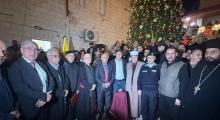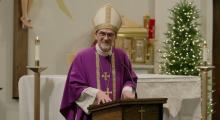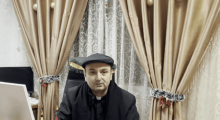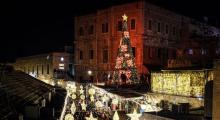Issued by the Catholic Center for Studies and Media - Jordan. Editor-in-chief Fr. Rif'at Bader - موقع أبونا abouna.org

Following is the text of Paschal Vigil Homily by His Beatitude Cardinal Pierbattista Pizzaballa, Latin Patriarch of Jerusalem, dated April 19, 2025:
Dear brothers and sisters,
May the Lord give you peace!
Today, we also do as the women do when they go early in the morning to anoint the body of Jesus. They see that the stone has been removed from the tomb and that the tomb is empty, and they wonder about the meaning of what has happened. (Luke 24:4) We too wonder about the meaning of what has happened.
We ask ourselves what is the meaning of what happened here two thousand years ago: what does the resurrection of Jesus mean for us, what does it bring back into our existence, especially in this time when everything seems to speak of the opposite, of death and darkness.
The readings this Vigil come to our aid and enlighten us: we must search for it in the pages of Scripture, just as the angels invite the women to do (“Remember what he said to you while he was still in Galilee”. (Luke 24:6) They invite them to remember the words of Jesus, to remember the Word. And that is exactly what this Vigil invites us to do. It invites us to make memory of the Word, to remember the long story of redemption that leads us to this evening.
We have heard the story of a long promise of life,the promise of a God who creates the world for the specific purpose of making a covenant with humanity. We started with creation and then went through the whole story of humanity being called to accept the gift of covenant with God and to take responsibility for the gift received.
It is a story of elections and falls that always starts over again and has this characteristic: When it seems to be over, finished, with no way out because of man’s hardness of heart, it begins anew. God intervenes and gives something new: he gives life, he gives freedom, he gives the Law, he restores a compromised relationship every time. He puts people back on the path, gives them strength and hope, gives them the certainty that he walks with us, among us. (cf. Ex 13:21)
This story begins, as we have already said, with man, who was created in the image and likeness of God to shine in his own glory. He is seen as a creature with supreme dignity and infinite freedom. “You have made him little less than a god, crowned him with glory and honor”. (Sl 8:6) But that was not enough. Instead of shining in the glory God gave him, instead of remaining in filial obedience to God, the source of true freedom, man chose to follow the deceptions of the Divider, and experienced death, the absence of God. Instead of God, he chose himself and enclosed himself in small horizons. With sin, with man’s refusal to live as a son, he was lost.
The readings of the Vigil bring us to this threshold, to this dramatic moment: we have lost our likeness to God, but only He can give us a new heart capable of living according to the plan of good life that has been placed in our hands. Thus, the last Old Testament reading, that of the prophet Ezekiel (Ezek 36:26-28) tells of God’s decision to transform man from the ground up, to heal his heart, to do something new that man alone can never do. In order to restore man’s likeness to Him, God must give him a new heart: External cleansing is not enough, it is not enough to forgive sin, because if the heart does not change, man will continue to drift away and lose his likeness to the Father again and again.
Jesus, the Word with whom God created the world and man, is the physician of souls, the One who can restore the original image that man has tarnished, He who can give us a new heart.
Yet even the death of Jesus may initially lead us to believe that this promise to restore our image in the image of God suffered a final setback at some point in history: Jesus, the fulfillment of the promise, the Amen of the Father, was killed and laid in a tomb. What happened was that Jesus, who had come to reveal the Father’s gratuitous love to humanity anew, who had come to help and heal all, (cf. Acts 10:38) was met with incomprehension and rejection by his own. He was betrayed, denied, sold, handed over, mocked, tortured, crucified and killed. In human terms, his life ended in the worst of all failures.
But we believe that on Easter morning, great news arrived. The women go to the tomb looking for Jesus in the realm of death, in the place of unlikeness, of distance from God. But this place of death is deserted. In the place of Jesus’ body stand two men clothed in light, proclaiming that Jesus is alive, (Luke 24:5) that the new man has been born.
Jesus is the one who handed himself over, who allowed himself to be killed, who did not defend himself, who did not for a moment give in to a logic of violence. And He did not do this out of weakness, but out of trust. He entrusted His life to the Father, and believed to the end that the Father would preserve it. In this Son, who remained anchored in the promise to the end, who loved to the end, the Father recognized the features of His own face, a man created again in His image and likeness.
This is the proclamation that I feel I must say again, first to myself and then to all of us and to our Church.
Everything here today seems to speak of death and failure, as that of Jesus. Perhaps we too are like the women in the Gospel, full of fears and with our faces bowed to the ground (Luke 24:5) and therefore unable to see beyond, caught up in so much pain and violence. We lose ourselves in so many analyzes, evaluations and projections of the dramatic situation we are experiencing. And we continue to base our hope on the decisions of politics, society and even religious life, which confirm their emptiness every time. In short, we imprison ourselves in the small horizons of always, unable to generate life, to create beauty, because fear can never generate life, has no light and cannot create anything beautiful. “Why do you seek the living one among the dead? He is not here!” (Luke 24:5) As long as we are trapped in our fears, we will be like the women in the Gospel and seek Jesus where he is not, namely in our graves.
So let us ask Jesus to re-enter our tombs and bring us into the light, to give us back the life we thirst for, to give us a new heart that is able to trust and give.
Let us remember what the Lord has done for us and let us focus our eyes on how much He is still at work through the many resurrected people of this time, who even in these dark times are still able to give and trust, who shine with light and thus restore the image of God in man day by day. We ask that our hearts vibrate again with life, with trust, with gift, with love.
This is the meaning of Jesus’ resurrection for us, and this is the meaning of Easter, in every age, until today, and this is what we celebrate today: the faithfulness of God’s love, a love that overcomes even death and gives us back the dignity of children of God, who are free and loved forever.
Happy Easter!







